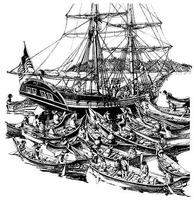Fur Trade, Maritime
FUR TRADE, MARITIME, began with the arrival of Russian traders in the Gulf of Alaska in the 1740s. The Spanish sent naval expeditions from California and Mexico to forestall the Russian advance in the 1770s, but the heyday of the trade on the BC coast dates from the publication of accounts of James COOK's 1778 visit to the coast. Cook's men had traded for SEA OTTER pelts and exchanged them in China. The first British trader to arrive was Capt James Hanna with his brig the Sea Otter in 1785. He traded furs in NOOTKA SOUND that fetched over $20,000 in Canton, and the rush was on. The first American in the trade was Robert GRAY, who arrived in 1789. By 1800 American traders, mainly from Boston, dominated the trade. Furs from the coast were taken to Canton and exchanged for tea, silk, porcelains and sugar. In the peak years from 1790 to 1812 there were as many as 2 dozen vessels on the coast, trading tens of thousands of pelts. Coastal FIRST NATIONS people were experienced traders who drove a hard bargain. In exchange for their furs they obtained guns, metalware, cloth and liquor. Relations between traders and aboriginals were often strained by ignorance and suspicion, and there were instances of violence on both sides. The trade expanded the wealth of the coastal people and seems to have stimulated their ceremonial and artistic lives. But it also introduced diseases such as SMALLPOX, which eventually led to drastic population decreases. By the 1820s trade was in decline and the HBC was taking over from American traders and establishing forts on the coast (see FUR TRADE, LAND-BASED).
Reading: James R. Gibson, Otter Skins, Boston Ships and China Goods: The Maritime Fur Trade of the Northwest Coast, 1785–1841, 1992.

